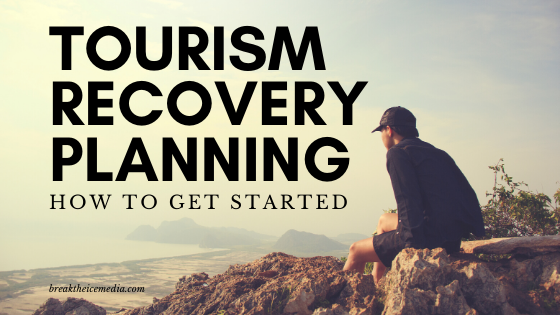Tourism Recovery Planning: How to get started
The signs of recovery are starting to bubble up. Which means that for tourism businesses and organizations, it’s time to start recovery planning. It’s time to reevaluate the world and circumstances around us and create a plan for recovery and reopening.

Recovery is the final of the four phases of a crisis. Adapted from Hong Kong agency Sinclair, the other phases of crisis are immediate response, pivot & adapt and market revival. Heading into June 2020, we are entering the market revival stage of this pandemic as phased openings of non-essential businesses are happening across the US. During this phase, society needs time to adjust and trust. Destinations and tourism businesses should use positivity and optimism in communications and consider creative campaigns to re-engage consumers and capture opportunities for business growth.
Next Step: Recovery Planning
In the next stage, recovery, brands should promote health and safety measures, provide strong calls-to-action, highlight off-the-beaten path activities or attractions, incentivize visitors with packages and deals and reward loyalty.
We rounded up these emerging travel trends that you should consider for your recovery planning:
- Travelers will care about health, safety, trust and flexibility.
- There will be an emphasis on outdoor, open-air attractions and destinations.
- Visitors will be looking for intimate settings for small groups and off-the-beaten-path destinations.
- Day trips and drive markets will return first.
- Don’t forget the new channels and offerings created during the pandemic.
- Digital and virtual experiences will remain popular.
- Consider how to transition online back into offline, brick-and-mortar activations.
- Visitors will likely need added value and incentive to travel.
- Visitors continue to seek confidence that their money is secure in the event of a cancellation.
- Baby Boomers’ adoption of technology will change how they plan travel.
Recovery Messaging
Now is the time to think ahead to recovery messages and the reassurances that you will need to provide as we enter the market revival and recovery phases of the pandemic. These messages may need to live on your website long-term and should include:
- Communicating increased safety, health screenings and mandates around protective gear.
- Detailed cleaning procedures within attractions and areas that see a volume of touch and interaction, to address increased expectations for sanitation.
- Establishing physical distancing measures and ways of enforcing when offering an experience to several groups of travelers simultaneously.
- Continuation of new offerings – such as retaining to-go beverage pick-up or keeping virtual offerings even post-pandemic.
- Phased openings and experiences.
- Flexible booking and cancellation policies.
Show the Experience
And be prepared to show – don’t just tell – to gain the trust and confidence of the travelling public, showing them what they will experience will go a long way.
Recently, Marriott released their commitment to clean as they prepare for re-opening around the world. This commitment lives on their website, was sent out through an eNewsletter and includes a video to show guests what they can expect when they are ready to travel again. The opening of Marriott’s Commitment to Clean website reads:
“As we welcome you back to our hotels around the world, we are committed to providing you with a safe environment that aligns with expert protocols for working to defeat COVID-19. Consisting of in-house and outside experts in food and water safety, hygiene and infection prevention, and hotel operations, our Marriott Cleanliness Council is redefining our cleaning and safety standards. We will actively monitor and evolve our solutions to ensure a continued focus on the health and safety of our guests and associates.”
You don’t have to be one of the largest hotel chains in the world to show your customers what the experience will be like when they are ready to visit. Fly Creek Cider Mill near Cooperstown, NY, made a fun video shared on their social channels to show their visitors their in-store experience, which includes multiple hand sanitizing stations and disposable gloves to use while shopping.
Another example is Papa Jack’s Ice Cream in Victor, NY. Their social media video shows off the customers’ choices of ordering ice cream outside or inside and includes floor markers to keep parties 6 feet apart, staff wearing PPE masks and hand sanitizing stations.
Showing helps set the expectations for the experience and sets the guests at ease.
Destination-wide Standards
Another way that destinations are helping set visitors at ease is by creating a destination-wide commitment to set standards. On May 13, 2020, Savannah, Georgia’s Mayor unveiled the Savannah Safe initiative that is a voluntary program asking local businesses to commit to CDC and FDA COVID-19 sanitation and safety guidelines. All of the businesses who take the pledge are listed on the SavannahSafe.com website. And North Carolina launched Count on Me NC as a mutual pledge and public health initiative that empowers guests and businesses to help keep everyone safe and protected.
Find more useful resources on our Marketing through the Crisis page where we are curating travel and tourism industry resources for recovery planning and reopening guidelines.
Author
Related Posts
Communication: The 3 C’s of World-Changing Collaborations
Big ideas and big achievements don’t happen alone. They require teamwork and a shared goal. That’s why collaboration is essential, especially in the travel and…
Mindsets & Marketing: How Embracing a Growth-Mindset Can Set Your Destination up for Success
We learned that having a growth mindset – or calling yourself “growth-minded” – is more than just forward motion. It is a willingness to work,...
